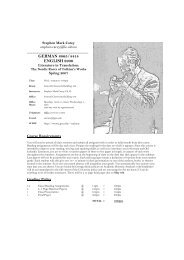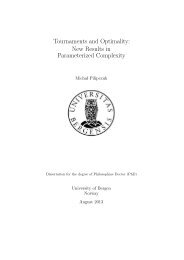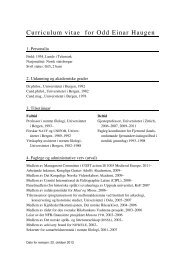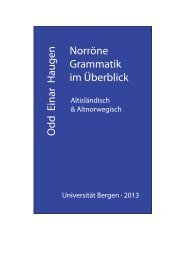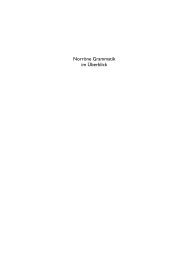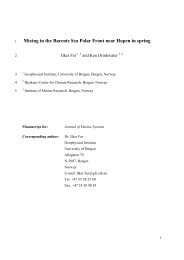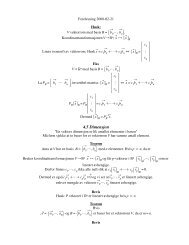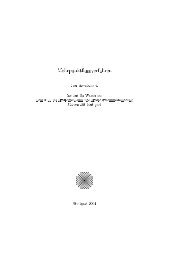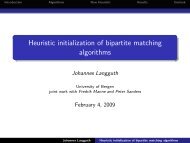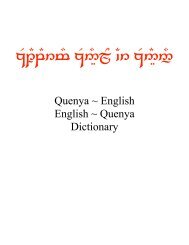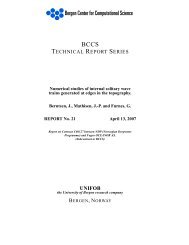a commentary on jrr tolkien's tengwar transcription of
a commentary on jrr tolkien's tengwar transcription of
a commentary on jrr tolkien's tengwar transcription of
You also want an ePaper? Increase the reach of your titles
YUMPU automatically turns print PDFs into web optimized ePapers that Google loves.
caita: Note here that the diphth<strong>on</strong>g ai in this case is written with the a-diacritic<br />
above the tengwa calma, followed by the semi-vowel yanta.<br />
hísie: The s here should not be written with a silme (or again in this case, a silme<br />
nuquerna), but rather with a súle/thúle, as the word hísie (S. hith) is descended from<br />
a base KHITH- (cf. Hísime = S. Hithui, the name <strong>of</strong> the eleventh m<strong>on</strong>th <strong>of</strong> the<br />
Númenórean calendar). Thus it should be rendered as 9~B3B`V. 16<br />
vanwa: Like avánier above, this is derived from AWA. Therefore the v should be<br />
written with a vilya, not a vala, thus: nE5nE. Note also that Tolkien used the <strong>tengwar</strong><br />
númen and vilya to represent the diagraph nw. One could have used the tengwa<br />
nwalme instead, but strictly speaking, this can <strong>on</strong>ly be used to represent the sound<br />
ñw (< *ŋgw).<br />
Aside from this, note also that Tolkien used “Quenya capitals” when writing proper<br />
nouns such as Varda, Oiolosse, Andúne, Rómen, Valimar. It is also in this poem that<br />
some Tengwar punctuati<strong>on</strong> marks have become known for the first time. Tolkien<br />
used the symbol À to represent the query mark, and Á to represent the exclamati<strong>on</strong><br />
point.<br />
NOTES<br />
1 Facsimiles <strong>of</strong> the letter (both in diacritic mode and in the Mode <strong>of</strong> Beleriand (MoB)) can be<br />
found in IX:130-131. But I would like to take this opportunity to comment <strong>on</strong> this transcripti<strong>on</strong> as<br />
well: in the <strong>tengwar</strong> versi<strong>on</strong> <strong>of</strong> A Elbereth Gilth<strong>on</strong>iel (using the Mode <strong>of</strong> Beleriand) as well as the<br />
Moria-gate inscripti<strong>on</strong>, 6 represents n (5 being nn), but in the MoB versi<strong>on</strong> <strong>of</strong> the King’s Letter,<br />
6 was used to represent r as well, thus ljlk]6 = Elessar.<br />
2 The dust cover is a scan <strong>of</strong> the First Editi<strong>on</strong>. The Sec<strong>on</strong>d and Third Editi<strong>on</strong>s have a different color<br />
scheme and appearance but retain the <strong>tengwar</strong> text. It must be noted that the page references in<br />
this article are <strong>of</strong> the First Editi<strong>on</strong>.<br />
3 In the first versi<strong>on</strong> <strong>of</strong> my rendering <strong>of</strong> the text, I used Måns Björkman’s Tengwar Parmaite f<strong>on</strong>t as<br />
Johann Winge’s f<strong>on</strong>t was <strong>of</strong> yet unavailable. The editors <strong>of</strong> Vinyar Tengwar likewise use Winge’s<br />
f<strong>on</strong>t.<br />
4 The URL is http://www.uib.no/People/hnohf/namarie.htm.<br />
5 Compare this to the Moria-gate inscripti<strong>on</strong>, where ll is rendered as two lambi as seen in mell<strong>on</strong><br />
“friend”: yljjh6.<br />
6 But strangely enough, if <strong>on</strong>e would write the word óre in <strong>tengwar</strong>, rómen is used to represent r,<br />
and not the tengwa óre! See The Lord <strong>of</strong> the Rings p. 1088 s.v. R, and ibid. pp. 1094 and 1095.<br />
7 See V:393, s.v. THŪ.<br />
8 See VT47:35.<br />
9 See esp. VT39:17 note 2.<br />
10 See VT49:10,32 and PE17:189.<br />
11 See XI:366.



